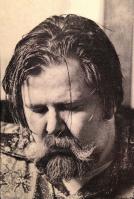 Dave Van Ronk nei primi anni '60 era uno dei nmi più importanti del Greenwich Village di New York, dove si andava affermando anche il giovane Bob Dylan
Dave Van Ronk nei primi anni '60 era uno dei nmi più importanti del Greenwich Village di New York, dove si andava affermando anche il giovane Bob Dylan
*
Dave Van Ronk (June 30, 1936 February 10, 2002) was a folk singer born in Brooklyn, New York, who settled in Greenwich Village, New York City, and was nicknamed the "Mayor of MacDougal Street."
He was best known as a pioneer of the acoustic blues revival, but his work ranged from old English ballads to Bertolt Brecht, rock, New Orleans jazz, and swing. He was a pioneer of instrumental ragtime guitar, as well as an early supporter of Bob Dylan and Joni Mitchell, among many others. Van Ronk was very influential on the music scene in New York City in the 1960s.
Van Ronk moved from Brooklyn to Queens in 1951 and began attending Richmond Hill High School. He had been performing in a barbershop quartert group since 1949, but left it after high school to do a stint in the Merchant Marine.
In 1956 he began his professional music career, touring colleges and small venues in the Beat scene. He performed blues, jazz and folk music, writing his own songs and doing new arrangements of classics. Initially he strived to revive traditional jazz, later observing: "We wanted to play traditional jazz in the worst way...and we did!" The jazz revival didn't take off though, and Van Ronk turned to performing blues music he'd stumbled across and enjoyed years earlier, by artists like Furry Lewis and Mississippi John Hurt. Van Ronk was not the first white musician to perform African-American blues, but became noted for his interpretation of it in its original context.
He became noted both for his large physical stature and his expansive charisma, which belied an intellectual, cultured gentleman of many talents. Among his many interests: cooking, science fiction, world history, and politics. During the 1960s he supported radical political causes and was a member of the Libertarian League. He took part in the infamous Stonewall Riots during which he was beaten. In 1974 he appeared at a concert with his old friend Bob Dylan, to aid refugees from the military coup by Augusto Pinochet in Chile.
In 2000 he performed at Blind Willie's in Atlanta, clothed in garish Hawaiian garb, speaking fondly of his impending return to Greenwich Village. He reminisced over tunes like Good Ol Wagon, a song he says was humorous back in 1962. He was married to Terri Thal in the 1960s, lived for many years with Joanne Grace, then married Andrea Vuocolo, with whom he spent the rest of his life. He continued to perform for four decades and gave his last concert just a few months before his death. A street in Greenwich Village was named after him in 2004. He found it amusing to be called "a legend in his own time."
Van Ronk died before completing work on his memoirs, which were finished by his collaborator, Elijah Wald, and published in 2005 as The Mayor Of MacDougal Street.
He has been described as an irreverent and incomparable guitar artist and interpreter of black blues and folk, with an uncannily precise ability at improvisation. Joni Mitchell often said that his rendition of her song Both Sides Now (which he called Clouds) was the finest ever.
Dave Van Ronk is perhaps underestimated as a musician and blues guitarist. His guitar work is noteworthy for both syncopation and precision, showing similarities to Mississippi John Hurt's. He ranks high in bringing blues style to Greenwich Village in during the 1960s. During this crucial period, he performed with the likes of Bob Dylan and spent many years teaching guitar in Greenwich Village. The Japanese singer Masato Tomobe learned from him,too.
Van Ronk was among the first to perform traditional jazz and ragtime on the acoustic guitar. His guitar arrangements of such ragtime hits as St. Louis Tickle, The Entertainer and Maple Leaf Rag continue to frustrate and challenge aspiring guitar players.
Van Ronk refused for many years to fly and never learned to drive (he would use trains or buses or, when possible, recruit a girlfriend or young musician as his driver), and he declined to ever move from Greenwich Village. Van Ronk's trademark stoneware jug of Tullamore Dew was frequently seen on stage next to him in his early days.
Robert Shelton described Van Ronk as, "the musical mayor of MacDougal Street, a tall, garrulous hairy man of three quarters, or, more accurately, three fifths Irish descent. Topped by light brownish hair and a leonine beard, which he smoothed down several times a minute, he resembled an unmade bed strewn with books, record jackets, pipes, empty whiskey bottles,lines from obscure poets, finger picks, and broken guitar strings. He was Bob (Dylan's) first New York guru. Van Ronk was a walking museum of the blues. Through an early interest in jazz, he had gravitated toward black music -- its jazz pole, its jug-band and ragtime center, its blues bedrock.....his manner was rough and testy, disguising a warm, sensitive core. Van Ronk retold the blues intimately....for a time, his most dedicated follower was Dylan."
http://en.wikipedia.org/wiki/Dave_Van_Ronk